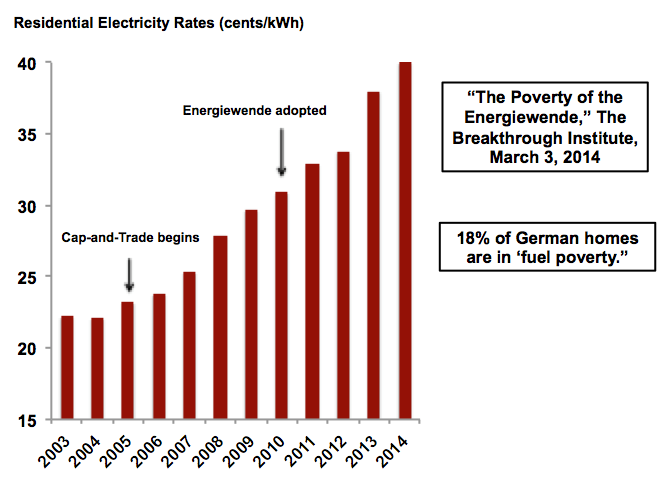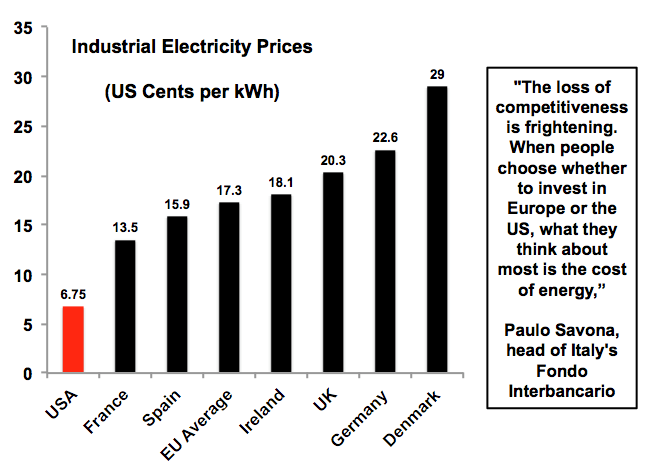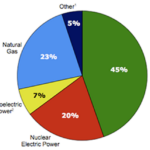Europa’s energiebeleid leidt tot hogere elektriciteitsprijzen, verlies aan internationale concurrentiekracht, deïndustralisering, energiearmoede onder lagere inkomensgroepen en meer extra winterdoden onder kwetsbare groepen in de samenleving. In tegenstelling tot wat vaak wordt beweerd, leidt het niet of nauwelijks tot vermindering van de CO2-uitstoot en niet tot minder afhankelijkheid van buitenlandse leveranciers van fossiele brandstoffen, zoals Rusland.
Het is goed om af en toe kennis te nemen van de visie van buitenlandse waarnemers van wat er in Europa gebeurt. Zij houden ons een spiegel voor.
Onder de titel, ‘Europe’s Energy and Electricity Policies are a Bad Model’ schreef Jude Clemente onlangs in Forbes:
It’s quite telling that COP21 took place in Paris. Western leaders, environmental groups, and international institutions are convinced that Europe is the model for the rest of the world to install more renewable energy and efficiency. Entered into force in 2005, Europe has been a mainstay of the failed Kyoto Protocol, the first agreement for country-by-country reductions in greenhouse gas emissions. And the European Union Energy Roadmap 2050 wants the EU to cut its emissions 80% below 1990 levels by 2050, setting milestones for reductions of the order of 40% by 2030 and 60% by 2040.
But, the truth is much different. Europe is a “green energy” basket case with surging prices, fleeing industry, falling economic and population growth, growing dependence on Russian energy, and rising “fuel poverty,” where even the Middle Class often can’t afford the most basic energy services. “Soaring energy costs make Europeans poor.”
To illustrate, Denmark and Germany are the proud wind capitals of Europe, but they also have the highest home electricity prices on Earth, 42 and 40 cents per kWh, respectively, against just 12.5 cents in the U.S. Germany has embarked on a $1.4 trillion energy transition (“Energiewende”) that has resulted in recent Der Spiegel headlines like: “Germany’s Energy Poverty: How Electricity Became a Luxury Good.”
Naturally intermittent and more expensive, wind and solar power have surged under Germany’s very expensive energy plan, and the goal remains to get as much as 60% of power from renewables in 2035, versus 28% today. Undeniably non-sensically, Germany has been paying over $26 billion per year for electricity that has a wholesale market value of just $5 billion …
Endlessly ignored by those promoting renewables and/or those directly invested in the business itself, higher cost electricity (and energy) is horrible for our health. That’s because, since electricity is so indispensable, meaning that it “cannot not be used,” higher cost power drastically erodes our disposable income, which is the very basis of our health – while also disproportionately hurting the poor most. As a percentage of income, poor families pay 5-9 times more for electricity than rich families do.
Predictably silently, higher cost electricity in Europe is killing tens of thousands of people a year, ”Excess Winter Deaths,” where older residents on fixed budgets in particular are forced to turn their heat down to avoid overly expensive utility bills. For example, there were 44,000 Excess Winter Deaths in England and Wales in 2014-2015 (…). Critically, although we keep hearing about the dangers of a warmer world, “cold kills 20 times more people than heat.”
Europe’s industry is being ravaged by exorbitant energy costs: “Brussels fears European ‘industrial massacre’ sparked by energy costs.” … The once-vaunted UK steel industry, for instance, has been decimated by higher cost electricity (…), and annual production is down 15% to 12 million tonnes since 2007, now just yielding 1.5% of what mighty China does.
Europe’s Ridiculously High Industrial Electricity Prices (1st half, 2015)
Source: Eurostat; IEA
Any of us that have taken even just one basic Economics class must stop those in the sacred-cow business of promoting renewable energy from constantly ignoring these higher costs that devastate. …
The direct loss of industry because of higher cost electricity is particularly destructive. Manufacturing jobs are very high-paying and the manufacturing business greatly advances nations with a massive “multiplier effect,” where 1 new manufacturing job can create as many as 6 or 7 across the overall economy.
While the manufacturing sector in the EU now employs about 30 million persons directly, down from 37 million 10 years ago, the real devastation is far worse because manufacturing is a building block of a strong economy.
Moreover, energy dreams that are based on more renewable energy at all costs, exacerbated by a refusal to more realistically produce as much domestic coal, oil, and natural gas as possible, have upped Europe’s dependence on Vladimir Putin’s more reliable hydrocarbons. Russian gas, for instance, now supplies 65% of Europe’s natural gas imports, compared to 45% in 2010. More reliable coal and gas still supply 5 times more electricity than wind and solar do in the EU, even after tens of billions in subsidies for renewables.
And never forget that, given the importance of energy, higher cost energy trickles down to increase the costs of EVERYTHING that we do and/or enjoy. For example, the costs of water, an even more indispensable necessity than electricity, are dangerously much higher in Europe because power is way too expensive (….):
Because the energy required for treatment and delivery of water accounts for as much as 80% of its cost, an insufficient supply of affordable energy will have a negative impact on the price and availability of water ..
Sandia National Laboratories
Aldus Jude Clemente.
Lees verder hier.
Wat mij altijd verbaast, is dat het collectief handelen van hele legerscharen hoog–intelligente, hoog–gekwalificeerde en hoog–betaalde politici, ambtenaren, wetenschappers en techneuten, toch af en toe een grote puinhoop oplevert.
Voor mijn eerdere bijdragen over klimaat en aanverwante zaken zie hier, hier, hier, hier en hier.








Mooi stuk, prima begin van het nieuwe jaar.
De energiepolitiek wordt het Waterloo van de EU, simpelweg omdat het spot met de natuurwetten.
Volgens de bijbel zal het mensen vergeven worden als zij spotten met de Vader of de Zoon, maar geen vergeving is er voor spot met de Heilige Geest. Waarom?
Zie de Vader als de som van alle energie in het universum. De Zoon is dan de manifestatie hiervan: massa, beweging, licht… Dit ontkennen is dom, maar gevaarloos. De Heilige Geest echter staat voor de natuurwetten waaraan alles onderworpen is. Hiermee spotten levert straf op. Zoals een sprong van de Eiffeltoren niet wordt overleefd.
En wat te denken van het demoniseren en het betitelen van CO2 als vervuiling? Welke straf zou deze verdwaasden passen?
Ja, we kunnen er lang en breed over praten, maar feitelijk is er in de EU helemaal geen sprake van energie- grondstoffenbeleid. Zoiets verondersteld namelijk een gedeelde visie …. eenheid.
Op het moment dat zich een opportuniteit voordoet wordt er vanuit de diverse Europese Commissie onderdelen een ambtelijk apparaat wordt opgetuigd waarin wordt besproken óf werkelijk interessant is en vooral of het interessant is voor ALLE lidstaten (wat natuurlijk nooit het geval is). Vervolgens zwermt er een leger van jonge wetenschappelijk en ambtelijk begaafde stagiaires uit om de zaak in kaart te brengen, wordt gesproken met betrokken partijen over wensen, eisen en tegenprestaties en worden de Europese eisen en wensen m.b.t. duurzaamheid, corruptie en maatschappelijk verantwoord ondernemen nog maar eens stevig onderstreept.
“Jaren later”, terug in Brussel begint het vergaderen pas goed op gang te komen. Immers dan gaat het om de inzet van middelen en hoeveel de lidstaten moeten bijdragen, welke bedrijven deelname gegund wordt en dus welke niet.
Ondertussen zijn de Chinezen al met de Afrikaanse dorpshoofden aan het onderhandelen waar de wegen en scholen worden aangelegd, hoeveel Chinese en hoeveel Afrikaanse “slaven” te werk worden gesteld en hoe de poet verdeeld wordt.
Vanuit Westers oogpunt niet zo “clean” allemaal maar wel lean en natuurlijk ook een tikje mean.
Als het erom gaat energie en grondstoffen tegen zo laag mogelijke prijzen beschikbaar de houden / krijgen is Europa zijn eigen vijand.
Misschien dat Dolf meer weet over hoe deze processen verlopen binnen de “Uni”.
“Als het erom gaat energie en grondstoffen tegen zo laag mogelijke prijzen beschikbaar de houden / krijgen is Europa zijn eigen vijand.”
Inderdaad. Dit doet me denken aan een gesprek dat ik had met een ambtenaar van postbus 51 in 2014. Ik belde om mijn zorgen te uiten over de Energieverkenning 2014, waarin middels een drogredenering werd gesuggereerd dat zonnepanelen zorgen voor goedkopere elektriciteit. Ik gaf aan dat dit mij zorgen baarde omdat dit soort misvattingen ertoe kunnen leiden dat er verkeerde politieke beslissingen gemaakt worden waardoor onze energiekosten zullen stijgen. Het geruststellende antwoord van Postbus 51: “De energiekosten worden sowieso hoger.”
En klaar ben je als bezorgde burger.